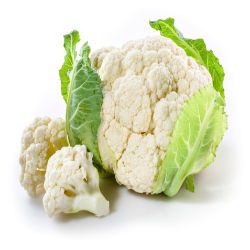Cauliflower Nutrition facts
Cauliflower

Cauliflower (cabbage flower) is one of the familiar winter season vegetables. These beautiful flower heads are brimming with essential nutrients, hold numerous health-benefiting phytonutrients such as vitamins, indole-3-carbinol, and sulforaphane that help prevent overweight, diabetes and offer protection from prostate, ovarian, and cervical cancers.
Botanically, it is a member of the cruciferous or Brassicaceae family of vegetables and has a similar nutritional and phytochemistry profile as that of other brassica family veggies like broccoli and cabbage.
As in broccoli, cauliflower is also made up of tightly clustered florets that begin to evolve but halt at an immature (bud) stage. This cool-season vegetable prefers moisture-rich, fertile soil to flourish.
Other than the common snow-white variety, several cultivars exist including green, orange, purple, and romanesco heads.
| Nutrition Principle | Nutrition Value | Percentage of RDA |
|---|---|---|
| Principle | ||
| Energy | 25 Kcal | 1% |
| Carbohydrates | 4.97 g | 4% |
| Protein | 1.92 g | 4% |
| Total Fat | 0.28 g | 1% |
| Cholesterol | 0 mg | 0% |
| Dietary Fiber | 2.0 g | 5% |
| Vitamins | ||
| Folates | 57 µg | 14% |
| Niacin | 0.507 mg | 3% |
| Pantothenic acid | 0.667 mg | 13% |
| Pyridoxine | 0.184 mg | 14% |
| Riboflavin | 0.060 mg | 4.5% |
| Thiamin | 0.050 mg | 4% |
| Vitamin A | 0 IU | 0% |
| Vitamin C | 48.2 mg | 80% |
| Vitamin E | 0.08 mg | 0.5% |
| Vitamin K | 15.5 µg | 13% |
| Electrolytes | ||
| Sodium | 30 mg | 2% |
| Potassium | 299 mg | 6% |
| Minerals | ||
| Calcium | 22 mg | 2% |
| Copper | 0.039 mg | 4.5% |
| Iron | 0.42 mg | 5% |
| Magnesium | 15 mg | 3.5% |
| Manganese | 0.155 mg | 7% |
| Zinc | 0.27 mg | 2.5% |
| Phyto-nutrients | ||
| Carotene-ß | 0 µg | -- |
| Lutein-zeaxanthin | 1 µg | -- |